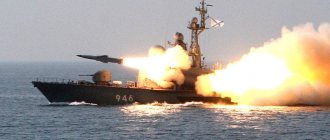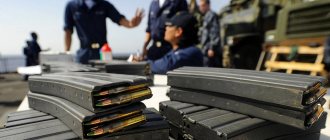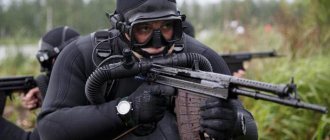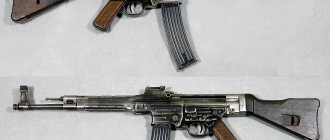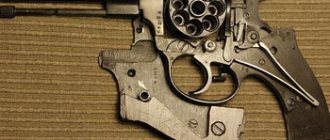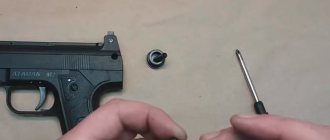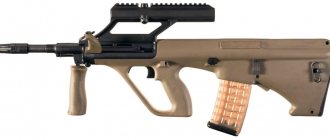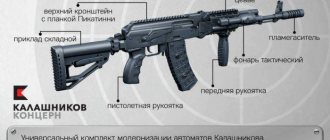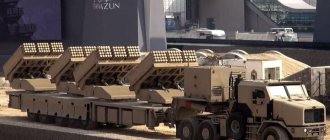The Kalashnikov assault rifle has certainly become one of the most popular assault rifles not only in Russia, but throughout the world. Over its more than half-century life, the machine gun has undergone a number of improvements, the transition to many different calibers, body kit with modern polymers, and so on. Nevertheless, its design has become a symbol of the reliability and “survivability” of Russian weapons.
The newest version of the assault rifle, the AK-12, is already being actively introduced into service in various army units. The armies of the eastern and western military districts have already received the first batches of weapons and are actively preparing them for service - studying their features, conducting shooting and maintenance. Special forces teams are also mastering the new product.
But against the backdrop of the grand march of the AK-12 throughout the world of weapons, we should not forget that Russian gunsmiths also created other assault rifles. Often they were just a copy of the Kalash in a slightly different wrapper. For example, the OTs-14 “Groza” is an assault complex in which the Kalashnikov assault rifle mechanism was converted using a bullpup system. There is nothing unusual in such a modification - a proven design can sparkle with new colors in a different design.
But there were other machines that did not copy the AK design, but demonstrated something new. Weapon designers, through trial and error, created new weapons that could become effective where the Kalash was weak. It is these machines that we will talk about.
AK-47 and AKM
The Kalashnikov 1947 model was designed to use a 7.62*39 mm caliber cartridge. Well-known designers, for example, Degtyarev, Shpagin, Sudaev and Simonov, took part in competitions for the development of an assault rifle for these bullets. The winner was a newcomer - M. T. Kalashnikov, who was not popular at that time.
The first model of the weapon went through a number of updates, after which the AK-47 assault rifle was adopted for service in 1949. Following this, work on its modification continued. In 1959, an updated version began to be supplied to the troops; it was called the AKM. The weapon is simple, reliable and inexpensive to manufacture. The Kalashnikov assault rifle has been adopted by over 100 countries.
The evolution of the assault rifle in the USSR and Russia in the context of the American NGSW program
Kalashnikov assault rifle model 1947, modernized Kalashnikov assault rifle (AKM) and Kalashnikov assault rifle chambered for the low-pulse AK-74 cartridge
Development of machine guns in the USSR
Since the mid-20th century, the main small arms of the armed forces of the Russian Federation (RF) has been the Kalashnikov assault rifle.
After the adoption of the Kalashnikov assault rifle model 1947 (the same AK-47) chambered for the 7.62x39 mm intermediate cartridge, its design was continuously improved, primarily in terms of increasing the manufacturability of the design. Shortly after the adoption of the M16 rifle chambered for the low-pulse intermediate cartridge 5.56x45 mm in the United States, the USSR adopted the AK-74 assault rifle chambered for a similar low-pulse intermediate cartridge 5.45x39 mm. In addition to improving the design of the Kalashnikov assault rifle, the USSR also considered other types of small arms that could presumably replace the Kalashnikov assault rifle in the ranks of the Soviet armed forces.
Prototypes of Nikolai Afanasyev's assault rifles
Prototypes of German Korobov's assault rifles
Experimental machine gun E.F. Dragunov
Experienced Stechkin assault rifle
No less actively, the Soviet Union considered the possibility of using various types of ammunition in promising small arms, including those with swept-type sub-caliber bullets. However, none of the cartridges being developed were brought into service and into mass production, and at the time of the collapse of the USSR, the same low-pulse cartridge of 5.45x39 mm caliber remained the main ammunition for small arms in the USSR.
Experimental cartridges and arrow-shaped sub-caliber bullets developed in the USSR
Systematic work on the new machine gun has been carried out in the USSR since 1978 as part of the Flazhok research work (R&D), and then, since 1981, as part of the Abakan development work (R&D). The main requirement of the Abakan design and development work can be considered to be an increase in the accuracy of fire from a machine gun in automatic mode. Eight prototypes took part in the competition for the new machine gun, with several versions - TKB-0111 designed by G. A. Korobov, TKB-0136 N. M. Afanasyeva, TKB-0146 I. Ya. Stechkina, V. M. Kalashnikov AKB. , APT Postnikova I. A., AEK-971 Koksharova S. I. and Garev B. A., AEK-978 Pikinsky P. A., AS Nikonova G. N.
From top to bottom TKB-0111 (Korobov G. A.), TKB-0136-3M (Afanasyev N. M.), TKB-0146 (Stechkin I. Ya.), AEK-971 (Tarev B. A.), AEK- 978 (Pikinsky P. A.), ASM (Nikonov G. N.)
The TKB-0146 assault rifles of I. Ya. Stechkin and G. N. Nikonov’s ASM, which used a scheme with a shift in recoil impulse, providing a significant increase in the accuracy of fire in short bursts, reached the finals of the Abakan R&D project.
Stechkin's assault rifle I.Ya. TKB-0146, made according to the bullpup scheme, was rejected. Part of the reason could be a certain conservatism of the military in terms of the bullpup layout, but one cannot help but note a significant drawback of this machine - the need for double chambering of the cartridge (the cartridge is fed into the barrel through an intermediate feeder by two jerks of the bolt handle).
The Nikonov G.N. ASM assault rifle was put into service under the designation AN-94, but in fact, it was not purchased in significant quantities. It is believed that this happened due to the collapse of the USSR and the lack of appropriate funding, but in fact the AN-94 is an extremely complex and specific weapon that does not have radical advantages over the AK-74 in 5.45x39 mm caliber.
Nikonov assault rifle arr. AN-94 "Abakan"
Development of automatic machines in the Russian Federation
In Russia, the selection of a new assault rifle for the armed forces began in 2012 as part of the creation of advanced combat equipment for servicemen (RokR “Warrior”), commissioned by the Ministry of Defense (MoD). The scale of the competition to select an assault rifle within the framework of the Ratnik design and development project was clearly not comparable to the Abakan design development project of the Soviet period. In fact, information is known about the choice between the modernized Kalashnikov assault rifle NPO IZHMASH, released under the code AK-12 in caliber 5.45x39 mm and AK-15 in caliber 7.62x39 mm, A-545 and A-762 assault rifles (modernized AEK-971 ), respectively, also in calibers 5.45x39 mm and caliber 7.62x39 mm, developed at the plant named after. Degtyarev and 5.45A-91 and 7.62A-91 assault rifles in a bullpup configuration, developed by TsKIB SOO, a branch of KBP JSC. The AK-12 / AK-15 and A-545 / A-762 emerged as finalists, and at the first stage of the competition, machine guns from the plant named after. Degtyarev performed better than the machines of NPO IZHMASH.
Automatic machines from the plant named after. Degtyarev A-545 caliber 5.45x39 mm and A-762 caliber 7.62x39 mm
There was no talk about new ammunition, and we couldn’t make a final decision on the choice between 5.45x39 mm and 7.62x39 mm ammunition, so we decided to leave both. The main caliber is still considered to be 5.45x39 mm, but from time to time information appears that the option of returning to the 7.62x39 mm cartridge as the main caliber of small arms is being considered.
Meanwhile, the new Kalashnikov assault rifles, having undergone significant transformations, entered the second part of the competition. As they were “optimized,” the new Kalashnikov assault rifles lost their futuristic appearance and some of the previously announced functions—bilateral controls, slide stop, and quick barrel replacement.
NPO Izhmash assault rifles of the AK-12 / AK-15 series - from prototype to production model
The competition ended in a rather specific way. It seems that the AK-12/AK-15 series assault rifles won, but the A-545 and A-762 assault rifles with balanced automatics will also be purchased for special units. The main reason for choosing the AK-12 / AK-15 assault rifles is stated to be their lower cost, only several times (two or three?) higher than the cost of the AK-74, while the cost of the A-545 and A-762 assault rifles is supposedly higher the cost of an AK-74 is about ten! once. The contract provides for the delivery of one hundred and fifty thousand AK-12 and AK-15 assault rifles within three years. It is planned to deliver fifty thousand machines in 2022, 2022 and 2022. It is not reported in what proportion AK-12 and AK-15 will be supplied. It is also unknown how many A-545 and A-762 assault rifles will ultimately be purchased. However, we can assume that eventually both plants will get their piece of the budget pie.
A number of sources question the feasibility of purchasing AK-12, AK-15, A-545, A-762 assault rifles. For AK-74/AK-74M assault rifles, products of the type “Kalashnikov assault rifle modernization kit” (KM-AK) have been developed according to the “Kalashnikov assault rifle” design and development work, which makes it possible to improve the ergonomics of these weapons and provide the ability to install additional equipment. The ergonomics of the AK-74/AK-74M in the “body kit” are practically no different from the ergonomics of the AK-12, AK-15, A-545, A-762 assault rifles, while the increase in their efficiency hardly justifies the purchase at a price ranging from two to ten times higher than the cost of AK-74/AK-74M, despite the fact that the latter are available in huge quantities in warehouses. It is possible to create a similar “body kit” for AKM assault rifles of 7.62x39 mm caliber, thereby completely closing the line of assault rifles for the armed forces in 5.45x39 mm and 7.62x39 mm calibers.
Modernization kit for the Kalashnikov assault rifle “Body kit”
There is also an opinion according to which Kalashnikov assault rifles produced in the seventies and early eighties are superior in quality to those produced now, but to what extent this information corresponds to reality and in what condition these weapons are in storage warehouses, there is no reliable information.
What can be assumed for sure is that kits like the "Kit" cost much less than new weapons, and for the armed forces is an order of magnitude less attractive than the supply of new weapons. Although it is possible that the best solution for the armed forces would be to purchase 300-500 thousand “Kobves” kits than to purchase 150,000 machine guns with conditionally improved characteristics. However, apparently, this is already a matter of the past.
The NGSW program and its consequences for the RF Armed Forces in case of success or failure
When in the United States there was talk about switching to a new 6.5-6.8 mm caliber cartridge, the opinion spread widely that cartridges such as 6.5x39 mm Grendel or 6.8x43 mm were being considered as the new main ammunition of the US armed forces. Remington SPC. In extreme cases, something new, for example, the same telescopic cartridge Textron Systems 6.8CT / 7.62CT, but with approximately the same energy 2200-2600 J. However, judging by the latest information about the NGSW program, a new cartridge caliber 6.8 mm is supposed to be made with an energy of about 4000-4600 J, which is more than that of the existing 7.62x51 mm 7.62x54R rifle cartridges.
Cartridges 5.56x45 mm, 6.5x38 Grendel, 6.8x43 Rem SPC, 7.62x51 mm
As discussed in a previous article, due to the high expected power of the promising 6.8mm cartridge, the US military may face the same problems that plagued them in Vietnam with the M14 rifle chambered for 7.65x51mm.
Based on this, two scenarios for implementing the NGSW program can be considered:
1. Participants in the NGSW program
will not be able
to create a weapon that simultaneously provides a significant increase in range and high armor penetration, combined with sufficiently low recoil and an acceptable weapon weight.
In this case, weapons created under the NGSW program will occupy a limited niche in the US armed forces. The largest acquisition of the US Armed Forces in this case will be the NGSW-AR machine gun chambered for the new 6.8 mm caliber cartridge, which is being considered to replace the M249 SAW machine gun chambered for the 5.56x45 mm caliber cartridge. The NGSW-R rifle, being developed to replace the M4, will most likely occupy the niche of the Marksman weapon, displacing the mentioned M14 rifle from it.
As for the bulk of American military personnel, they will either have to be content with weapons chambered for 5.56x45, or its equivalent, but chambered for one of the mentioned cartridges such as 6.5x39 Grendel or 6.8x43 Rem SPC. If a new weapon is developed for the promising telescopic cartridge Textron Systems 5.56CT / 6.8CT / 7.62CT, then its energy will not be at the level of 4000-4600 J, but at the same level of 2200-2600 J, most likely quite achievable in the 7.62x39 mm cartridge.
2. Participants in the NGSW program will be able to
create a weapon that simultaneously provides a significant increase in range and high armor penetration, combined with sufficiently low recoil and an acceptable weapon weight.
In this case, the US armed forces will carry out a phased transition to new weapons. At first, special operations forces (SSO) will be armed with it, then the most belligerent units, and then all the rest.
Possible responses of the Russian Armed Forces to the NGSW program
If scenario 1 is realized, when weapons sold under the NGSW program receive limited distribution, retaliatory measures may cost the Russian armed forces “little blood.”
A single Pecheneg machine gun chambered for 7.62x54R caliber or its modernized version can be considered as a weapon to counter the promising American NGSW-AR machine gun of 6.8 mm caliber. Potentially inferior to the promising American machine gun in terms of the weight of the weapon itself, the weight of the ammunition and the flatness of the trajectory, it will traditionally surpass it in reliability. The Pecheneg machine gun can be upgraded to reduce weight, but the main means of increasing its effectiveness should be the development of upgraded 7.62x54R ammunition with increased accuracy and armor penetration.
Single machine guns "Pecheneg" and "Pecheneg-SP" caliber 7.62x54R
A similar situation arises with the Marksman rifle. It can be either a modernized version of the SVD rifle of 7.62x54R caliber, or promising weapons such as the Chukavina sniper rifle (SHF).
Chukavina sniper rifle caliber 7.62x54R
A variant of the AK-308 assault rifle chambered for 7.62x54R may also be developed, which could claim the same niche as the FN SCAR-H and HK-417 rifles of 7.62x51 mm caliber.
AK-308 assault rifle, caliber 7.62x51 mm
The most difficult task will be making a decision on the final choice between calibers 5.45x39 mm and 7.62x39 mm, in the event that most of the US military personnel switch to weapons chambered for 6.5x39 Grendel, 6.8x43 Rem SPC cartridges with an energy of 2200-2600 J (as we said earlier, such a scenario is possible if weapons capable of completely replacing the M4 rifle under the NGSW program are not created, but the 5.56x45 mm caliber is finally declared ineffective)
.
The question of the feasibility of switching from the 7.62x39 mm cartridge to the 5.45x39 mm cartridge and back is periodically raised both in the press and, apparently, in the armed forces. At the beginning of 2022, in the thematic collection “Rocketry, artillery and technical support of the Armed Forces of the Russian Federation - 2018”, information emanating from the Ministry of Defense of the Russian Federation again appeared that the issue of abandoning the armed forces from small arms of 5.45x39 mm caliber was being considered and a complete transition to 7.62x39 mm caliber. It can be assumed that these throwings are also related to information about the transition to a larger caliber of the US Army.
By the way, the transition from the 5.45x39 mm cartridge to the 7.62x39 mm cartridge can send almost all new weapons purchased under the Ratnik program to warehouses, which confirms the haste in making decisions on this program.
The claimed advantages of 5.45x39 mm cartridges compared to 7.62x39 mm cartridges are largely due to the fact that modern 7.62x39 mm cartridges are not developed or produced. It can be assumed that if a promising armor-piercing cartridge is developed in 7.62x39 mm caliber, with design solutions similar to those used in the 7N39 "Igolnik" cartridge of 5.45x39 mm caliber, then the characteristics of a promising armor-piercing cartridge of 7.62x39 mm caliber with an initial energy of 2200- 2600 J will exceed not only the characteristics of the 7N39 cartridge, but also the promising American cartridge based on the 6.5x39 Grendel or 6.8x43 Rem SPC. The promising armor-piercing cartridge of 7.62x39 mm caliber can also use modern solutions to reduce the weight of the cartridge, in order to prevent a significant reduction in the weight of the carried ammunition compared to that for weapons of 5.45x39 mm caliber.
As a basis for developing weapons for a promising armor-piercing cartridge of 7.62x39 mm caliber, with an initial energy of 2200-2600 J, we can consider the RPK-16 light machine gun, implemented in 7.62x39 mm caliber. The advantage of this weapon is its heavy, quickly replaceable barrel, which should increase shooting accuracy and ensure prompt replacement of the barrel when its resource is exhausted (which is important for cartridges with increased initial energy and bullet speed). The weight of the RPK-16 in the version with a short barrel is 0.8 kg more than the weight of the AK-12 assault rifle, which can be considered acceptable, taking into account the fact that the weight of the AN-94 assault rifle adopted for service was 3.85 kg.
RPK-16 machine gun, 5.45x39 mm caliber, with a short barrel
An important addition to a promising 7.62x39 mm weapon based on the RPK-16 could be a silencer designed to reduce recoil and partially reduce/distort the sound of a shot, similar to how it is implemented in the American NGSW program.
Instead of chrome plating, barrel carbonitriding technology may be considered to improve barrel survivability. The carbonitriding process consists of diffusion saturation of the surface layer of the treated channel with carbon and nitrogen, as a result of which the surface layer acquires a hardness of up to 60 HRC, increased wear resistance and corrosion resistance. Unlike chrome plating, carbonitriding does not change the geometric dimensions of the barrel bore, so carbonitriding does not affect the accuracy and accuracy of the weapon, which makes this technology a more progressive method of protection. According to manufacturers, the lifespan of a carbonitrated barrel should be at least 10-15 thousand shots.
Thus, the Russian response to the NGSW program “if it is partially successful” (scenario 1) may look like this:
1. Upgraded “Pecheneg” machine gun of 7.62x54R caliber with reduced weight. 2. An upgraded SVD rifle or Chukavina sniper rifle of 7.62x54R caliber or a variant of the AK-308 assault rifle with increased accuracy and accuracy chambered for 7.62x54R. 3. New 7.62x54R caliber cartridge with increased accuracy and armor penetration. 4. New 7.62x39 mm caliber cartridge of increased accuracy and armor penetration with an initial energy of 2200-2600 J. 5. 7.62x39 mm caliber assault rifle based on the RPK-16 light machine gun with a supersonic silencer and carbonitriding of the barrel.
As for the second scenario, in which participants in the NGSW program will be able to create a weapon that simultaneously provides a significant increase in range and high armor penetration, combined with sufficiently low recoil and an acceptable weight of the weapon, then in this case it will not be possible to get off with little loss.
It will be necessary to carry out complex and expensive research and development work, intensive testing, as well as costly rearmament of the RF Armed Forces with a new cartridge and weapons for it.
According to information provided by the director of the cluster of conventional weapons, ammunition and special chemicals of Rostec Sergei Abramov to the TASS news agency, the Rostec state corporation is developing small arms in new calibers. Exactly what calibers we are talking about is not specified. It is reported that in August 2019, the Central Research Institute of Precision Engineering (JSC TsNIITOCHMASH) received a patent for the invention of a modular firearm. Presumably, these works were activated precisely as a response to the American NGSW program.
In the following material, we will try to suggest what projects and concepts can be implemented by Russian industry if the implementation of the NGSW program is successful with the prospect of replacing the M4 rifle with the NGSW-AR rifle chambered for the promising 6.8 mm caliber cartridge.
AN-94 "Abakan"
Since the rearmament of the army with the new Kalash, the Soviet Ministry of Defense has been trying to obtain weapons that would not be inferior to the AK in terms of reliability. The department also wanted to develop an assault rifle that was superior to the AK-47 in terms of shot accuracy.
The next attempt to develop such a firearm occurred in the 80s. During this period, Soviet engineers began working on the creation of Abakan. According to plans, the firearm was supposed to become more powerful than an AK and double the effectiveness of shots when using the same cartridges. At the same time, the weapon should not be inferior to the AK in reliability.
A new weapon, the Nikonov assault rifle, was adopted by the Russian army in 1994.
The characteristic features of the Abakan design are distinguished by the fact that when firing, the barrel moves back, recoil decreases. In the two-round or long burst mode, the first couple of shots are fired at a rate of 1800 per minute. Subsequent ones - 600 per minute.
The magazine is placed with a slight inclination to the right side due to the peculiarities of the firing mechanism. The designers assumed that the Abakan would replace Kalashnikov assault rifles, but the weapons were produced in small batches that did not meet the needs of the active army.
AEK-971
Assault rifles designed by Garev-Koksharov have always been the main competitor to the Kalashnikov assault rifle. The first model, AEK-971, was created as part of the Abakan program. A special feature of the AEK design is its balanced gas automation. Unlike the AK, the AEK gas piston is connected to a counterweight, which, when fired, reduces the recoil impulse when firing. The machine gun does not bounce when fired, which significantly improves the accuracy of fire. Compared to the AK-74, accuracy has improved almost twice.
© kalashnikov.com
The AEK-971 model was created as part of the Abakan program.
It was also proposed to install an adjustable muzzle brake-compensator - by changing the size of the holes, it was possible to improve the accuracy of shooting from unstable positions, for example on the move. Unfortunately, this idea did not receive the green light - representatives of the Ministry of Defense considered this system too complex.
However, the AEK-971 was still more accurate than the AK-74. After a slight modernization, the Ministry of Internal Affairs units received three versions of the machine gun, using ammunition of different calibers. Like the AN-94, the AEK is considered a special forces weapon - more accurate, but requiring special training. Production of the machine lasted until 2006, after which it was suspended.
In parallel with the AK-12, a modernized version of the AEK-971 called A-545 also took part in the 2014 competition for a combined arms assault rifle. History repeated itself - the A-545 again outperformed the Kalash in shooting accuracy, but had a worse price-quality ratio. Nevertheless, the new machine gun, like its large-caliber version A-762, satisfied all the requirements of the Ministry of Defense and were included in the “Ratnik” equipment. According to experts, the A-545 will enter service with the special forces of the Armed Forces, the FSB and the National Guard - the elite of the Russian army.
AK-12 and AK-15
In order to participate in the “Ratnik” competition to create new automatic weapons for special forces, the development of the AK-12 began in 2011. Its design was often modified. As a result of the updates, the AK-15 was created - a later version of the AK-12 firearm.
The new modification is designed as a small weapon for special units; it is intended to replace the previous generation of machine guns. Updated samples of AK-12 and AK-15 firearms were successfully tested, they were sent for military testing to special forces. The weapon can use magazines from weapons of previous generations.
AM-17
The assault rifle came off the production line in 2022; it is presented as a replacement for the AKS-74U firearm. The basis for the new weapon was the MA model, which was designed by E. Dragunov.
All elements of the weapon are mounted on a plate, thus reducing the weight of the machine gun. To reduce weight, polymers were introduced into the material. The ergonomics of the firearm have improved - engineers from Kalashnikov are trying to create weapons that are easy to use. A short automatic carbine designed for use in special law enforcement units.
A silent version of the assault rifle has also been created - AMB-17. It uses a built-in muffler. You can change the caliber used.
What is an automatic machine
It should be noted right away that the term “machine gun” is not used everywhere in relation to a certain type of firearm. In the West, they prefer to use the designation “assault rifle,” that is, “assault rifle.” In addition, even in the USSR for a long time, submachine guns such as PPSh or PPS were called machine guns. This terminology changed only in the post-war period.
In the modern interpretation, a machine gun should be called an individual small weapon capable of continuous fire and using medium-power cartridges - stronger than pistol cartridges and weaker than rifle cartridges. A separate point is the length of the barrel. For example, the M16, despite the fact that it fired low-impulse 5.56 mm cartridges, was considered a rifle in the Soviet classification, but its shortened version, known as the M4, is already an assault rifle.
American M4 automatic carbine. Noticeably shorter than the “basic” M16
Sometimes an alternative name is used - automatic carbine. In particular, this term was used by American military experts to refer to captured Kalashnikov assault rifles captured during the fighting in Vietnam. At the same time, now in the USA AKs of all modifications, M16 and M4 are called assault rifles, which once again indicates a certain “vagueness” of terminology.
SR3M "Whirlwind"
The machine gun was designed at the Klimov TsNIITOCHMASH in 1994. The basis for the new weapon was the silent special forces AS “Val”. This is a lightweight, small-sized machine, weighing 2.4 kilograms. The firearm can be used in combat at a distance of up to 200 meters. Powerful SP-6 9x39mm bullets make it possible to successfully penetrate the body armor of opponents with the highest degree of protection at a distance of 50 meters.
The most common version of the assault rifle, which gained popularity among special forces soldiers of the Russian Ministry of Defense, was the SR-3M. It differs from the original in its high ergonomics, the ability to install a muffler, metal magazines, and optics. In addition, the new modification has a folding frame stock and a new forend. Small size and fire power enable the weapon to operate effectively on the battlefield.
Carbine "Sarych"
The Sarych semi-automatic carbine was developed by gunsmith Alexander Shevchenko. The weapon is named after a bird of prey. The carbine uses the .308 Win cartridge. The firearm is configured using a bullpup system; it has a compact receiver with minimal bolt extension. Such a system helps make the rifle highly reliable; the influence of moving parts on the accuracy of shots is minimized.
The carbine has a non-standard innovative appearance. In its polymer casing, the weapon is more similar to the weapons of heroes from science fiction films than to modern machine guns. In addition to its futuristic appearance, the carbine has innovative functionality.
The barrel has Picatinny rails, used for mounting modern sights, and a camouflaged bipod is located below. The buttstock is equipped with special cheek and shoulder rests. Thanks to interchangeable barrels, the Sarych can serve as both an automatic rifle and a light machine gun.

